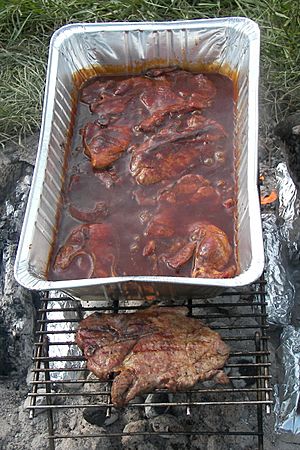St. Louis–style barbecue facts for kids
St. Louis–style barbecue is a special way of cooking spare ribs that comes from the city of St. Louis, USA. Unlike some other types of barbecue that cook meat slowly with smoke, St. Louis barbecue usually involves grilling the meat quickly. While it's sometimes compared to Kansas City–style barbecue, St. Louis barbecue has its own unique taste and cooking methods.
Contents
What Makes St. Louis Barbecue Special?
St. Louis–style barbecue is known for grilling meat and then adding sauce. It cooks faster than other barbecue styles. This is because it doesn't need hours of smoking or a dry rub.
St. Louis Barbecue Sauce
The barbecue sauce from St. Louis is made with tomatoes. It tastes sweet and a little bit sour, like vinegar. The main ingredients are usually ketchup, brown sugar, apple cider vinegar, salt, pepper, and other spices.
Special Rib Cuts
Traditional St. Louis ribs use a specific cut of meat called "spare ribs." These ribs are cut into a rectangular or square shape. This makes them look nicer and removes extra cartilage, so they have more meat.
Other Popular Meats
Besides ribs, other popular meats in St. Louis barbecue include:
- Brisket and burnt ends (crispy pieces of brisket)
- Pork ribs
- Pork steak
- Rib tips (the ends of the ribs)
- Snoots (pig noses and cheeks, often grilled until crispy)
White bread is a common side dish. People use it to soak up the delicious barbecue sauce.
Why St. Louis Barbecue is Popular
Barbecue is very popular in St. Louis. It's a big part of the city's culture. People often eat barbecue together at celebrations. This includes graduations, birthday parties, and sports tailgates.
Famous Barbecue Restaurants
St. Louis has many famous barbecue restaurants. Some award-winning places are Salt & Smoke, Sugarfire Smokehouse, and BEAST Craft BBQ Co. Food & Wine magazine even called BEAST Craft BBQ Co. the best barbecue in Illinois. Sugarfire Smokehouse helped make St. Louis–style barbecue well-known. They have many locations across several states.
Barbecue Competitions
St. Louis has a lively barbecue scene. Many barbecue competitions happen there each year. St. Louis–style ribs are often a category in these contests. Missouri has a long history of food competitions. They started with the annual Missouri State Fair in 1901. A popular local sauce is Maull's barbecue sauce.
The History of St. Louis Barbecue
People in St. Louis love barbecue sauce. Some say the city uses more barbecue sauce per person than any other U.S. city. Author Steven Raichlen describes St. Louis–style barbecue sauce as "very sweet, slightly acidic, sticky, tomato-based." It usually does not contain liquid smoke.
First Barbecue Sauce
St. Louis is believed to be home to the first barbecue sauce in the country. Louis Maull created it in 1926. In the 1950s, pork butt became a common meat in St. Louis barbecue. This happened when a local grocery store chain, Schnucks, started selling it.
Rib Cutting Style
St. Louis–style spare ribs are cut in a special way. The sternum bone, cartilage, and rib tips are removed. This creates a neat, rectangular rack of ribs for serving. This specific rib cut was officially recognized by the USDA as "Pork Ribs, St. Louis Style." It is said to have started with meat-packing plants in the area after World War II. Butchers found they could charge more for this cleaner cut. This cutting method became popular as local meatpackers advertised it as "St. Louis–style ribs." This helped them stand out from other companies.
Images for kids
See also
 In Spanish: Barbacoa al estilo San Luis para niños
In Spanish: Barbacoa al estilo San Luis para niños



